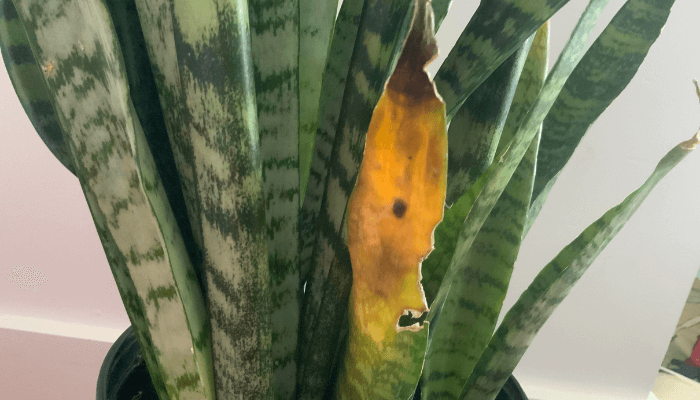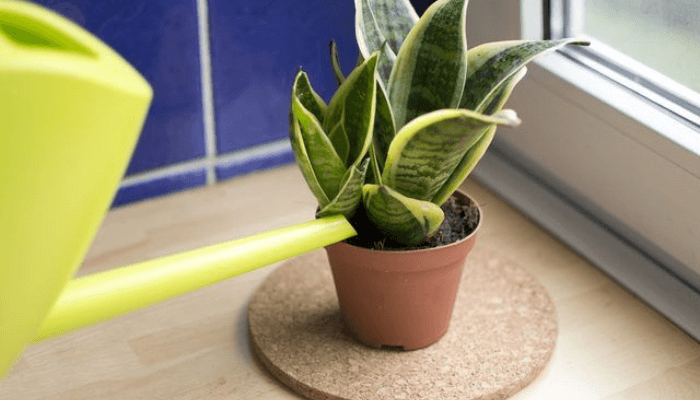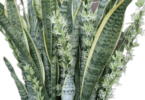Introduction
When a snake plant starts turning yellow, it’s a clear signal that something isn’t right. These resilient houseplants, hailed for their hardiness and unique aesthetic, are often the go-to choice for both novice and experienced plant enthusiasts. Native to West Africa, snake plants, or Sansevieria, have earned a reputation for their adaptability and air-purifying properties. Yet, even these sturdy plants can succumb to problems. One such common issue is the yellowing of their normally vibrant leaves. This article aims to provide an in-depth understanding of this issue, exploring its causes and offering solutions to keep your snake plant in its prime health.

Understanding Snake Plants
Native to West Africa, snake plants, or Sansevieria, thrive in arid, sub-Saharan regions. This gives them a unique ability to survive in less than ideal indoor conditions. These plants exhibit tall, pointed leaves with striking patterns, adding an element of architectural beauty to your interior decor. Beyond their aesthetic appeal, snake plants are known for their impressive air-purifying abilities, filtering out toxins such as benzene and formaldehyde, contributing to a healthier living environment.
The Snake Plant Yellowing Issue: Symptoms and Signs
A healthy snake plant boasts vibrant green leaves, but when health deteriorates, leaves of sneak plant start turning yellow, according with a scientific study. This yellowing typically commences at the edges before progressing inward. The affected leaves might lose their firmness, becoming soft or even mushy. Some plants may show additional signs such as browning tips, spots, or streaks. This overall loss of vibrancy is a clear distress signal from your snake plant, urging immediate attention. If you have other issues with your snake plant, read this article with tips to take care of your snake plants.
Causes of Snake Plant Turning Yellow
Several factors can cause snake plants to turn yellow:
- Overwatering or Underwatering: Snake plants store water in their leaves and can tolerate drought. Overwatering is a frequent problem, leading to root rot, which in turn results in yellowing. Conversely, underwatering can also stress the plant, causing similar symptoms.

- Inadequate Sunlight: These plants thrive in indirect light. Too much direct sunlight can scorch and yellow the leaves, while too little light can cause them to become dull and yellow.
- Poor Soil and Drainage: Snake plants prefer well-draining soil. Poor drainage can cause waterlogging and root rot, leading to yellowing leaves.
- Temperature and Humidity Issues: Extreme temperature fluctuations can stress snake plants, resulting in yellow leaves. Similarly, very low humidity can cause leaf tips to brown and yellow.
- Pest Infestations: Pests like mealybugs and spider mites can cause yellow spots on leaves.
- Nutrient Deficiencies: Lack of essential nutrients, especially nitrogen, can cause the leaves to yellow.
- Root Rot and Other Diseases: Root rot, often caused by overwatering, is a common disease that results in yellow, wilting leaves.
Troubleshooting and Corrective Measures
- Proper Watering Techniques: Water your snake plant sparingly and only when the top 2-3 inches of soil are dry. Overwatering can lead to root rot, a primary cause of yellowing.
- Adjusting Light Conditions: Ensure your plant is in a well-lit area, but away from direct sunlight. Too much or too little light can lead to yellowing.
- Improving Soil Quality and Drainage: Use a well-draining soil mix and ensure your pot has adequate drainage holes to prevent waterlogging.
- Maintaining Optimal Temperature and Humidity: Try to maintain a consistent temperature around your plant and avoid placing it near vents or drafty windows.
- Pest and Disease Management: Regularly inspect your snake plant for pests. If found, use an organic insecticidal soap or neem oil to treat the infestation. If root rot is suspected, remove the plant from the pot and cut off the affected roots before repotting.
- Supplementing Nutrients: Use a balanced, water-soluble fertilizer during the growing season, ensuring not to over-fertilize, which can lead to salt buildup and leaf burn.
- Treating Root Rot and Other Diseases: If your snake plant has root rot, remove the plant from the pot, cut away the rotted roots, and repot the plant in fresh, well-draining soil.
Prevention Tips to Keep Your Snake Plant Green
To prevent future yellowing issues, follow these tips:
- Routine Care for Snake Plants: Proper care is the best preventative measure. This includes correct watering, light, temperature, and humidity conditions.
- Regular Inspection for Early Detection of Issues: Regularly inspect your snake plant for signs of pests, diseases, or yellowing. Early detection often means a quicker, more successful recovery.
- Best Practices for a Healthy Snake Plant: Ensure your snake plant has well-draining soil, proper light, and a stable environment. Avoid overwatering and over-fertilizing, and regularly check for pests or other issues.
Conclusion
While snake plants are among the hardiest houseplants, they can sometimes struggle and start to yellow. However, with the knowledge of what causes yellowing and how to address it, you can quickly act to revive your plant. Remember, the key to a healthy snake plant is prevention and early detection. By following the tips outlined in this post, you will be able to revert snake plant turning yellow and can enjoy the beauty and benefits of your snake plant for years to come.



